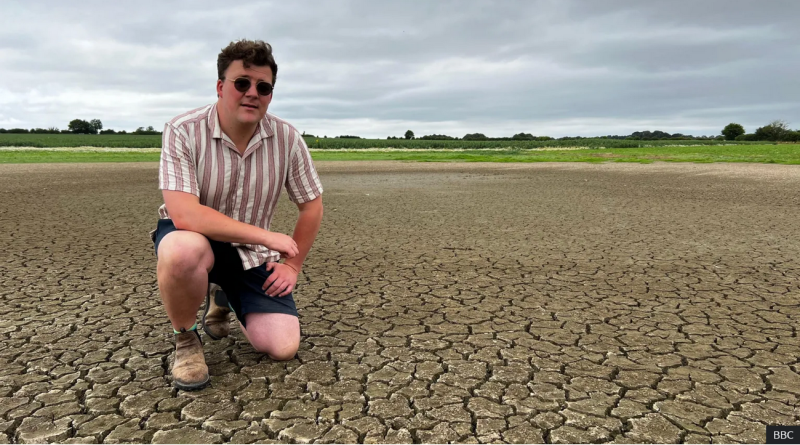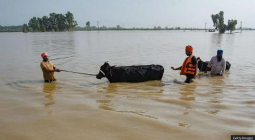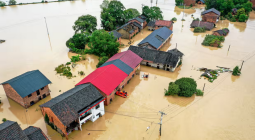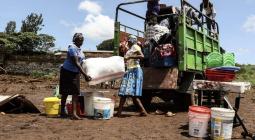After the floods: 'A catastrophic year' on farms

Farmers are counting the cost of the long, wet winter as they start to bring in record low harvests of grain.
The amount of wheat planted has fallen by nearly a tenth, and two thirds of British farmers say they have lost money.
Throughout winter and spring many fields were waterlogged, crops that had been sown were lost and farmers couldn’t get onto fields to sow anything.
Mike Wilkins, an arable farmer in Wiltshire, lost about half his wheat. He said: “We have lost thousands and thousands of pounds this year, it has been catastrophic.”
When I first met Mike Wilkins in May, he had a lake on his farm.
High on the Marlborough Downs, you could see for miles around.
But where wheat should have stood, there were swans and ducks paddling around.
Other fields were so wet the wheat sown had failed, rotting in the ground.
“If we don’t make a loss it will be a miracle,” he told me at the time.
Since then, the sun has come out and what wheat they could sow now looks OK.
“Don’t be fooled,” he says with a rueful smile. “It’s thin and full of weeds we couldn’t spray because the ground was so wet we couldn’t get a tractor on.”
The ears are golden now, and Mike picks a handful of grains to test for moisture.
He grinds them in a handheld device, which will tell him how moist the wheat still is.
“I need 15% max,” he shows me.
“But look – that’s still 19%, way too high.”
Just then, it starts to drizzle again.
“We need a few good solid sunny days to dry this, before we can cut it,” he tells me, looking at the dark clouds overhead.
It is anxious, stressful work, but this is actually a normal West Country harvest routine.
August is often wet, harvest always a tricky juggle.
Farmers wait for the perfect weather window, then crank up the combine, whatever the day or the hour, to get the harvest home
But this year is different. Even when they can get harvesting, much of the wheat never got sown in the first place.
On Mike’s farm, as well as the lake they had several fields so waterlogged they missed the moment to plant wheat. Later, as they dried out, he got some beans in which will go for cattle feed.
“Financially they will make hundreds and hundreds of pounds less per hectare,” he explains.
“This field is over 30 hectares, so that’s thousands of pounds less profit.
“And we have 200 hectares more like this. It’s been a really messy year.”
Mr Wilkins, and his sister and parents who farm here, are far from alone.
'Stark picture'
Official surveys from the Agriculture and Horticulture Development Board recently found the amount of wheat planted is 9% down, the lowest for 20 years. Oilseed Rape is 20% down.
At the National Farmers’ Union, they’ve reported their lowest ever farm confidence index. Some 65% of farmers say their incomes are down. 82% cited extreme weather as their biggest challenge.
NFU President Tom Bradshaw said the results “paint a really stark picture”.
“Confidence has collapsed after months of devastating flooding, unsustainably high production costs and low market returns, and against a backdrop of reduced farm support as we transition to a new Domestic Agriculture Policy and associated farm support," he says.
It was not just a wet winter, or a wet spring. Farmers had 18 months of rain, from September 2023 to May 2024 more rain fell than at any time since records began in 1836.
And experts agree this is "the new normal".
“We will get more extremes of weather,” says Prof Nicola Cannon, of Cirencester’s Royal Agricultural University.
“More wet winters, more dry summers, more extremes. And our soils are unable to cope, because of the way we have farmed them in the past.”
To see how farmers are now working differently, I revisit another farm that I last saw under water.
Debbie Wilkins’ farm had literally become a boating lake, her children kayaked on several miles of clear water which reached to the River Severn.
But she was philosophical about the hundreds of acres of pasture sitting under two metres of flood waters.
“They are just doing their job,” she told me in January.
"It takes the pressure off the river and protects the properties below us.”
Now, the grasses have come back. She shows me ancient wild grasses and flowers that have withstand long cold months under water.
“It’s green again, after six months of flooding,” she smiles.
But the length of the flood has cost her money. Normally, the grass would bounce back in the spring and they would cut 600 bales of hay from these meadows.
“We still haven’t taken a hay cut this year,” she says. “I think we’ll do well to get 150 bales.”
Ms Wilkins is part of a new movement called “Nature Friendly Farming”. The idea is to work with nature, using as few pesticides and insecticides as possible and “letting nature do the science”.
She shows me what she means in another field hit by the floods.
Like hundreds across the West Country, this field was waterlogged. It was meant for maize, to feed her cows. But with no chance to get a tractor on in the spring, she missed that planting.
Instead, once it had dried out, she “emptied the shed”, planting a random mix of crops.
Now it’s a rainbow of mustard, linseed, buckwheat, you name it.
“We’re trying to heal the soil”, Ms Wilkins explains.
“When there are plants growing in it, that will make the soil and the microbes function better when it’s either very wet or very dry, and we’ll need to add less chemicals to it.”
Prof Cannon says we need more of this.
"We need to build resilience in our soil, so it can rebound after extreme drought or rainfall.
"We’ve got to be prepared for more challenging conditions, be it floods or droughts. And we must condition our soil to work for us as the climate changes.”





